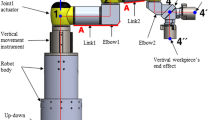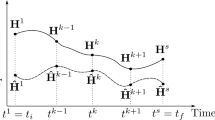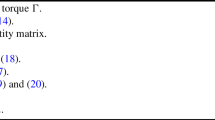Abstract
The end-effector of the large space manipulator is employed to assist the manipulator in handling and manipulating large payloads on orbit. Currently, there are few researches about the end-effector, and the existing end-effectors have some disadvantages, such as poor misalignment tolerance capability and complex mechanical components. According to the end positioning errors and the residual vibration characters of the large space manipulators, two basic performance requirements of the end-effector which include the capabilities of misalignment tolerance and soft capture are proposed. And the end-effector should accommodate the following misalignments of the mechanical interface. The translation misalignments in axial and radial directions and the angular misalignments in roll, pitch and yaw are ±100 mm, 100 mm, ±10o, ±15o, ±15o, respectively. Seven end-effector schemes are presented and the capabilities of misalignment tolerance and soft capture are analyzed elementarily. The three fingers-three petals end-effector and the steel cable-snared end-effector are the most feasible schemes among the seven schemes, and they are designed in detail. The capabilities of misalignment tolerance and soft capture are validated and evaluated, through the experiment on the micro-gravity simulating device and the dynamic analysis in ADAMS software. The results show that the misalignment tolerance capabilities of these two schemes could satisfy the requirement. And the translation misalignment tolerances in axial and radial directions and the angular misalignment tolerances in roll, pitch and yaw of the steel cable-snared end-effector are 30mm, 15mm, 6o, 3o and 3o larger than those of the three fingers-three petals end-effector, respectively. And the contact force of the steel cable-snared end-effector is smaller and smoother than that of the three fingers-three petals end-effector. The end-effector schemes and research methods are beneficial to the developments of the large space manipulator end-effctor and the space docking mechanism.
Similar content being viewed by others
References
PIEDBOEUF J. DUPUIS E. Recent Canadian activities in space automation & robotics-an overview[C]//Proceedings of the 7th ESA workshop on Advanced Space Technologies for Robotics and Automation ASTRA 2002ESTEC, Noordwijk, The Netherlands, November 19–21, 2002: 58–67.
LAWRENCE G, DERRY C. Satellite refueling system and method: US, US 2008/0237400 A1[P/OL]. 2008-03-10[2008-10-02]. http://www.freepatentsonline.com/y2008/0237400.html.
SALLBERGER C, FULFORD P, OWER C, et al. Robotic technologies for space exploration at MDA[C]//Proceeding of the 8th International Symposium on Artificial Intelligence, Robotics and Automation in Space i-SAIRAS 2005, Munich, Germany, September 5–8, 2005: 9–16.
UEDA A, KASAI T. HTV guidance, navigation and control system design for safe robotics capture[C]//AIAA/AAS Astrodynamics Specialist Conference and Exhibit, Honolulu, Hawaii, USA, August 18–21, 2008: 1–8.
KING D. Space servicing: past, present and future[C]//Proceedings of the 6th International Symposium on Artificial Intelligence and Robotics & Automation in Space i-SAIRAS 2001, St-Hubert, Quebec, Canada, June 18–22, 2001: 48–55.
QUITTNER E, VANDERSLUIS R, RAKHSHA J, et al. System and concept design of the SSRMS latching end effector[C]//Proceedings of the 3rd European Space Mechanism & Tripology Symposium, Madrid, Spain, September 30–October 2, 1987: 93–103.
BASIOBEDSKI P, GREENSPAN M, ROTH G. Pose determination and tracking for autonomous satellite capture[C]//Proceedings of the 6th International Symposium on Artificial Intelligence and Robotics & Automation in Space i-SAIRAS 2001, St-Hubert, Quebec, Canada, June 18–22, 2001: 1–8.
QUIOCHO L J, BRISCOE T J. SRMS assisted docking and undocking for the orbiter repair maneuver[C]//AIAA Guidance, Navigation and Control Conference and Exhibit, San Francisco, California, USA, August 15–18, 2005: 1–8
GRAY A M, JONES A S, KONG A. The thermal design, analysis and testing of the shuttle remote manipulator system[C]// Proceedings of AIAA 14th Thermophysics Conference, Orlando, Florida, USA, June 4–6, 1979: 1–6.
DOETSCH K. The remote manipulator system for the space shuttle orbiter[C]//Proceedings of the Annual Meeting of DGLR, Berlin, Germany, September 13–15, 1977: 261–269.
SALLABERGER C. Canadian space robotic activities[J]. Journal of Acta Astronautica, 1997, 41(4–10): 239–246.
PATTEN L, EVANS L, OSHINOWO L, et al. International space station robotics: a comparative study of ERA, JEMRMS and MSS[C]//The7th ESA workshop on Advanced Space Technologies for Robotics and Automation ASTRA 2002ESTEC, Noordwijk, The Netherlands, November 19–21, 2002: 1–8.
KUWAO F, OTSUKA A, HAYASHI M, et al. Operation concept on JEMRMS[C]//Proceedings of the 7th International Symposium on Artificial Intelligence and Robotics & Automation in Space i-SAIRAS 2003, Nara, Japan, may 19–23, 2003: 184–189.
SATO N, WAKABAYASHI Y. JEMRMS design features and topics from testing[C]//Proceedings of the 6th International Symposium on Artificial Intelligence and Robotics & Automation in Space i-SAIRAS 2001, St-Hubert, Quebec, Canada, June 18–22, 2001: 109–115.
WALKER B, VANDERSLUIS R. Design, testing and evaluation of latching end effector[C]//Proceedings of the 29th Aerospace Mechanisms Symposium, Leaue City, USA, May 17–19, 1995: 1–16
MENNENGA G. European robotic arm: Europe’s grip on the International Space Station[J]. AIR & SPACE EUROPE, 1999, 1(4): 62–63.
HEEMSKERK C J, VISSER M, VRANCKEN D. Extending ERA’s capabilities to capture and transport large payload[C] //Proceedings of the9th ESA workshop on Advanced Space Technologies for Robotics and Automation ASTRA 2006 ESTEC, Noordwijk, The Netherlands, November 28–30, 2006: 1–8.
GU Ming, PIEDBOEUF J C. A flexible-arm as manipulator position and force detection unit[J]. Journal of Control Engineering Practice, 2003, 11(4): 1 433–1 448.
RINGELBERG J. Docking assembly techniques and challenges R[C]//AIAA SPACE 2007 Conference & Exposition, Long beach, California, USA, September 18–20, 2007: 2 997–3 001
STAMM S, MOTAGHEDI P. Orbital express capture system: concept to reality[C]//Proceedings of Spacecraft Platforms and Infrastructure, Bellingham, WA, USA, August 30, 2004: 78–91.
TCHORYK P, HAYS A, PAVLICH J, et al. Autonomous satellite docking system[C]//Space 2001 Conference and Exposition, Albuquerque, New Mexico, USA, August 28–30, 2001: 1–7
BONOMETTI J A. Boom rendezvous alternative docking approach[C]//Space 2006 Conference and Exposition, San Jose, California, USA, September 19–21, 2006: 1–13
FEHSE W. Autonomous rendezvous and docking spacecraft[M]. New York: Cambridge University Press, 2003.
HERBERT F, MEE A. Grappling device: US, 4105241[P/OL]. 1976-10-15[1978-08-08]. http://www.freepatentsonline.com/4105241.html.
TAN Yisong, LIU Yiwei, LIU Hong, et al. Transfer vehicle cargo manipulating strategy in orbit using large-scale space end-effector[J]. Journal of Mechanical Engineering, 2011, 47(3): 109–115. (in Chinese)
FENG Fei, LIU Yiwei, LIU Hong, et al. Design and simulation analysis of a space end-effector with large misalignment tolerance[J]. Robot, 2011, 33(6): 691–699. (in Chinese)
Author information
Authors and Affiliations
Corresponding author
Additional information
This project is supported by National Hi-tech Research and Development Program of China(863 Program, Grant No. 2006AA04Z228)
FENG Fei, born in 1982, is currently a PhD candidate at State Key Laboratory of Robotics and System, Harbin Institute of Technology (HIT), China. He received his bachelor and master degree from HIT, China, respectively in 2005 and 2008. His research interests include large space manipulator end-effector and space docking mechanism.
LIU Yiwei, born in 1976, is currently an associate professor at State Key Laboratory of Robotics and System, HIT, China. He received his master degree and PhD degree from HIT, China, in 2002 and 2006, respectively. His current research interests include the dexterous robot hand and space robotics, etc.
LIU Hong, born in 1966, is currently a professor at State Key Laboratory of Robotics and System, HIT, China. He received his PhD degree in 1993 from HIT, China. Since 1993, he has been a research fellow at Institute of Robotics and System Dynamics of DLR, Germany. His current research interests include the dexterous robot hand and space robotics, etc.
CAI Hegao, born in 1934, is currently an engineering academician of China and a professor at State Key Laboratory of Robotics and System, HIT, China. His research interests include welding robot, industrial robot, space robot and the intelligent robot control, etc.
Rights and permissions
About this article
Cite this article
Feng, F., Liu, Y., Liu, H. et al. Design schemes and comparison research of the end-effector of large space manipulator. Chin. J. Mech. Eng. 25, 674–687 (2012). https://doi.org/10.3901/CJME.2012.04.674
Received:
Revised:
Accepted:
Published:
Issue Date:
DOI: https://doi.org/10.3901/CJME.2012.04.674




